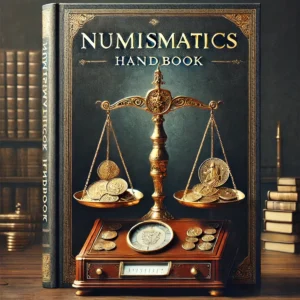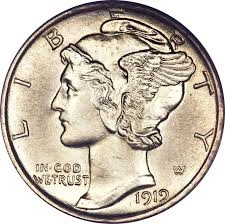Mercury Dimes: Key Dates, Errors & Pricing (1916 to 1945)
Discover the history, rare varieties, valuable key dates, and growing collector demand behind Mercury Dimes — one of the most beloved silver coins in U.S. numismatic history.

📘 Download the full guide: Numismatics Handbook — A +135-page expert resource on U.S. coin collecting.
Why Mercury Dimes Matter
Minted from 1916 to 1945, the Mercury Dime — officially known as the “Winged Liberty Head Dime” — captures the spirit of America between two world wars.
Created by legendary sculptor Adolph A. Weinman, the design features:
- Obverse: A young Liberty with winged cap, symbolizing freedom of thought.
- Reverse: A Roman fasces (bundle of rods) and an olive branch, representing strength and peace.
Collectors love Mercury Dimes for:
🪙 Stunning Classical Design — Arguably the most artistic U.S. dime ever made.
🥈 90% Silver Content — 0.07234 troy ounces per coin.
🔑 Key Dates and Rarities — Like the 1916-D and Full Bands strikes.
🧩 Full Bands Strike Challenges — Coins with fully separated crossbands command big premiums.
🔥 Affordable Entry — Easy to start collecting; opportunities for major upgrades later.
Whether you’re hunting rare dates, building a type set, or stacking silver, Mercury Dimes offer an incredible mix of beauty, history, and value.
Mercury Dime Values & Key Dates by Year
| Year | Mint Mark | Est. Value (Avg.) | Rare Variant? |
|---|---|---|---|
| 1916-D | D | $1,000–$20,000+ | Major Key |
| 1921 | No Mint | $150–$800+ | Scarce |
| 1921-D | D | $200–$1,200+ | Semi-Key |
| 1942/1 | No Mint | $400–$2,500+ | Overdate Error |
| 1942/1-D | D | $600–$3,000+ | Overdate Error |

✅ GoldSilverStacks Tip: Full Bands (FB) Mercury Dimes can sell for 2x–10x the price of weakly struck examples!
Key Features of Mercury Dimes
✨ Design Adolph Weinman’s artistic masterpiece, combining classical symbolism with American ideals of strength and freedom.
🏛️ Historical Significance Struck during World War I, the Roaring Twenties, the Great Depression, and World War II — capturing pivotal eras of American history.
🛠️ Mintage Periods Struck continuously from 1916–1945 across Philadelphia, Denver (D), and San Francisco (S) mints.
🥈 Composition 90% Silver, 10% Copper — standard for U.S. dimes before 1965.
💎 Collection Appeal Full Bands, low mintage dates, and pristine Mint State examples fuel major collector demand.
✅ Pro Tip: Focus on Full Bands strikes if you’re building an elite collection — they’re much rarer than normal Mint State pieces!
Most Valuable Mercury Dimes (Detailed Breakdown)
- 1916-D Mercury Dime — $1,000–$20,000+
- The king of Mercury Dimes; extremely low mintage (~264,000).
- 1942/1 Mercury Dime — $400–$2,500+
- Dramatic overdate — look for a faint “1” under the “2.”
- 1942/1-D Mercury Dime — $600–$3,000+
- Scarce Denver Mint overdate — highly prized by error collectors.
- 1921 Mercury Dime — $150–$800+
- Low mintage; condition-sensitive.
- 1921-D Mercury Dime — $200–$1,200+
- Key semi-key from the Denver Mint.

Comparison: Mercury Dimes vs Roosevelt Dimes
| Feature | Mercury Dimes (1916–1945) | Roosevelt Dimes (1946–Present) |
|---|---|---|
| Obverse Design | Winged Liberty Head | FDR Portrait |
| Reverse Design | Fasces & Olive Branch | Torch, Oak, and Olive Branches |
| Composition (pre-1965) | 90% Silver | 90% Silver |
| Key Dates | 1916-D, 1921, 1942/1 | 1949-S, 1950-S/D, 1964-D Doubled Die |
| Collector Appeal | Extremely High | Moderate for silver issues |
✅ GoldSilverStacks Insight: Mercury Dimes have significantly higher artistic, historical, and collector appeal compared to early Roosevelt Dimes.
Common Mercury Dime Errors and Varieties
🛠️ Top Mercury Dime Errors:
- 1942/1 Overdate — Very famous.
- 1942/1-D Overdate — Scarce and valuable.
- Off-Center Strikes — Premium for visible dates/mintmarks.
- Repunched Mintmarks (RPMs) — 1945-S has notable RPMs.
✅ Error Tip: PCGS or NGC slabbed error Mercury Dimes often bring 3x–5x raw coin prices!
How to Sell Mercury Dimes
Step 1: Identify Key Dates and Full Bands
- 1916-D, 1921, 1942/1 = High Value
- Full Bands examples = Bonus premium
Step 2: Grade Accurately
- MS63–MS67 coins are investment-grade.
Step 3: Pick the Right Platform
- eBay — Best for common circulated coins.
- GreatCollections — For certified coins MS63–MS67.
- Heritage Auctions — Elite rarities like 1916-D Full Bands.

✅ GoldSilverStacks Selling Tip: High-res photos that capture luster and full band detail sell faster at better prices!
How to Store and Preserve Mercury Dimes
🏛️ Use Archival Materials
- Acid-free flips, slabs, or capsules.
🌡️ Stable Environment
- Cool, dry storage to prevent tarnish and spotting.
🧤 Handle with Care
- Use gloves or hold by the edges.
🧽 Never Clean
- Natural toning is preferred — artificial cleaning kills value!
✅ Bonus: Attractive rainbow-toned Mercury Dimes can sell for premiums of 20–50%!
Frequently Asked Questions About Mercury Dimes
What are Mercury Dimes?
Mercury Dimes are U.S. 10-cent silver coins minted between 1916 and 1945. Designed by Adolph A. Weinman, they feature a winged Liberty on the obverse and a fasces with olive branch on the reverse, symbolizing strength and peace.
Why are they called Mercury Dimes?
Although the coin shows Liberty with a winged cap, early Americans thought the figure resembled the Roman god Mercury — the nickname “Mercury Dime” stuck, even though it actually represents Liberty.
What is the rarest Mercury Dime?
The 1916-D Mercury Dime is the rarest regular issue, with only about 264,000 minted. High-grade examples, especially with Full Bands detail, are extremely valuable.
How much silver is in a Mercury Dime?
Each Mercury Dime contains 0.07234 troy ounces of pure silver. They are composed of 90% silver and 10% copper.
What is a “Full Bands” Mercury Dime?
“Full Bands” (FB) refer to Mercury Dimes where the horizontal crossbands on the fasces are fully separated and sharply struck. Full Bands coins command major premiums over weakly struck examples.
What are the key dates for Mercury Dimes?
The key dates for collectors are 1916-D, 1921, 1921-D, 1942/1, and 1942/1-D. Coins with Full Bands from these dates are even more valuable.
How can I tell if my Mercury Dime is valuable?
Look for low-mintage dates (especially 1916-D), sharp strike details (Full Bands), mint condition grades, and major errors like the 1942/1 overdate. Certification by PCGS or NGC can confirm value.
Should I clean my Mercury Dime before selling it?
No. Cleaning a Mercury Dime removes its original surfaces and drastically reduces its value. Natural toning or slight wear is much more desirable to collectors.
Where is the best place to sell Mercury Dimes?
Common Mercury Dimes can be sold via eBay or local dealers. Rare dates, Full Bands examples, and certified coins should be sold through GreatCollections or Heritage Auctions for maximum returns.
Are Mercury Dimes a good investment?
Yes. Mercury Dimes offer strong collector demand, silver bullion value, and potential price appreciation — especially for scarce dates, Full Bands strikes, and high-grade examples.

